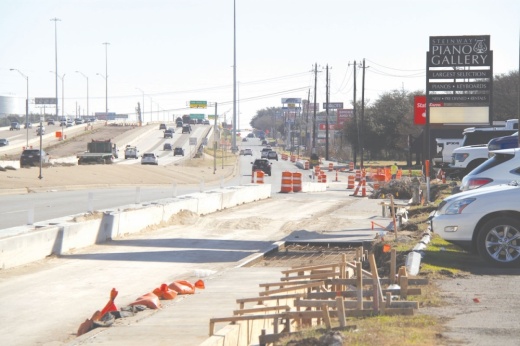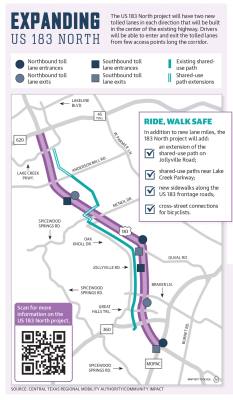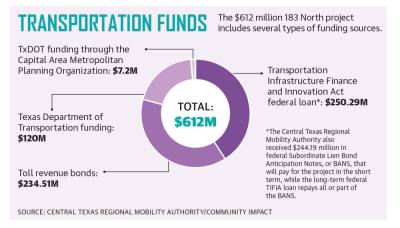The construction is part of the 183 North Mobility Project, a $612 million project on a 9-mile section of US 183 between SH 45 N/RM 620 and MoPac. The project will add two new tolled express lanes and a fourth continuous nontolled lane in each direction. Construction will also include adding and improving sidewalks and bicycle lanes along the service roads and bike lanes along the US 183 North corridor.
Once complete, the project is expected to address congestion and keep traffic flowing at peak times in the 183 North corridor. The added express lanes will connect to the existing express lanes on MoPac and to the 183A Toll in Cedar Park to allow for quicker access to commuters. It will allow emergency vehicles to respond in less time and allow Capital Metro buses free access.
“We’re really going to give people in this part of town options, different ways to get where they want to go. I think it’s going to have a huge impact on mobility and relief of congestion,” said Bobby Jenkins, chair of the Central Texas Regional Mobility Authority, the agency overseeing the project.
The project is already approximately 24% complete after breaking ground Jan. 26, 2022.
“This project has been years in the making and is an exemplary example of our commitment to improving multimodal mobility in our region as well as in being a good partner to the community as construction takes place and beyond,” said Mike Sexton, acting director of engineering for the Mobility Authority, in an email.
Addressing congestion and delays
TxDOT published a study in 2016 that showed by 2035 travel times on 183 North in rush hour could be as high as 50 minutes. The 183 North project was designed to improve traffic flow, reduce congestion, and give transit and first responders more reliable travel times, according to the Mobility Authority.
The highway has three existing nontolled main lanes in each direction, but the Mobility Authority will continue the fourth nontolled lane and add two tolled express lanes in each direction, said Sylvia Shelton, Mobility Authority assistant director of communications, in an email. The express lanes are being added in the center where the median is located to maintain the existing corridor footprint.
The new express lanes will work the same way as the express lanes on MoPac to fluctuating tolls and keep traffic flowing as it builds up in the adjacent nontolled lanes. This allows for timely travel and easier travel for emergency services, Shelton said in an email.
“The goal with any express lane, just like MoPac, ... [is] during rush hour periods, we raise the price so that we keep the traffic in that one lane or express lane flowing at 1,600 vehicles an hour. If you can put 1,600 vehicles [in that late], now your average speed will be about 45 miles an hour,” said Greg Mack, Mobility Authority director of information technology.
The rush hour toll will be higher to maintain the flow of traffic and keep it reliable, he said.
The express lanes will also allow Capital Metro to increase bus service during peak periods. In September 2021, Capital Metro announced its purchase of almost 200 new electric buses, which will be used in the corridor.
“We’re also committed to working with our partners in transit, which is why CapMetro buses and other registered carpool providers are able to take the express lanes for free, avoiding passing that cost on to customers and ensuring reliable public transportation routes through the corridor,” Shelton said.
Space for bicycles, pedestrians
Another aspect of the project is adding bike lanes and pedestrian crossings as well as closing sidewalk gaps to provide continuous travel for cyclists between SH 45 and MoPac. During the environmental phase of the project, Mobility Authority officials hosted open house events in 2014-15 for the public to learn more about the plan and offer input, as previously reported by Community Impact.
“Key elements of design shared by the community during the environmental phase are now a part of the project’s final design,” Shelton said.
Construction began in November to add new sidewalks and update existing ones to make them Americans with Disabilities Act-compliant along the US 183 frontage roads between RM 620 and Loop 360. Plans for bike lanes and shared-use paths for use by those not traveling by vehicle are also underway.
While the Mobility Authority has included bicycle lanes since the beginning of the design phase in 2013, it also sought input from the public and members of the city of Austin bicycle program, the city’s Bicycle Advisory Council and Bike Austin to update their designs.
Available right of way for bike facilities is constrained by existing utilities, driveways, steep slopes and drainage, Shelton said. The new design will allow a safer ride for bicyclists and pedestrians with cross-street connections, sidewalks and shared-use paths for nonmotorized vehicles, whenever feasible.
The Mobility Authority will also add landscaping and lighting for visibility and safety in the shared paths.
The Mobility Authority has invested $47 million in bicycle and pedestrian accommodations up to now, including current and completed work. The project will also add a total of 51 new high-mast lights and LED bulb upgrades to 20 existing high-mast lights, Shelton said.
Keeping residents informed
Work on the project continues 24/7, and the Mobility Authority keeps residents and neighborhood associations informed about temporary lane closures through its website and newsletters. Most lane closures are posted in advance and are outside of rush hours, Mobility Authority staff said.
Dimassi’s Mediterranean Buffet is one of several businesses affected by the 183 North construction. The entrance and exit to the parking lot are flanked by orange cones, cordoned off sidewalks and a partial lane closure, but once the work is done, the driveway will be wider and safer for customers to access the restaurant, manager Mohammed Tafory said.
“I am looking to the future. This [construction] is good,” Tafory said.
In 2021, the Mobility Authority met with homeowner associations and neighborhood associations virtually or in person within six communities along the corridor to inform them about construction, Shelton said. The aim was to also receive feedback.
Neighborhood associations, such as Forest Oaks, Anderson Mill and Balcones Village/Spicewood Springs neighborhoods, gave feedback and showed concern about flow of traffic through their neighborhood streets.
“Once you get into the neighborhood, there’s no problem. There is a little bit of congestion around the frontage road; sometimes when they have a lane blocked off, it backs up a little bit, but it’s never been too long,” said Carol Feist, president of the Anderson Mill Neighborhood Association.
Some neighbors still have concerns about how the project will alleviate congestion on local streets through neighborhoods.
Richard Greenwalt, who has been a resident of the Spicewood at Balcones Village neighborhood for 30 years, has seen the transition of Anderson Mill Road from a minor side street to a major bypass between US 183 and RM 620. He said it is difficult to make a left-hand turn in rush hour as cut-through traffic uses Anderson Mill Road from US 183 to reach RM 620.
Even after the construction is complete, he does not see this problem going away. He said he hoped the project would have completed the northbound US 183 flyover ramp to westbound RM 620.
“I think mostly they’re just focused on getting the tolled additional lanes on [US] 183 going north, but I don’t think it’s really attacking the interchange between [US] 183 and [RM] 620, which I was hoping it would do,” Greenwalt said.









